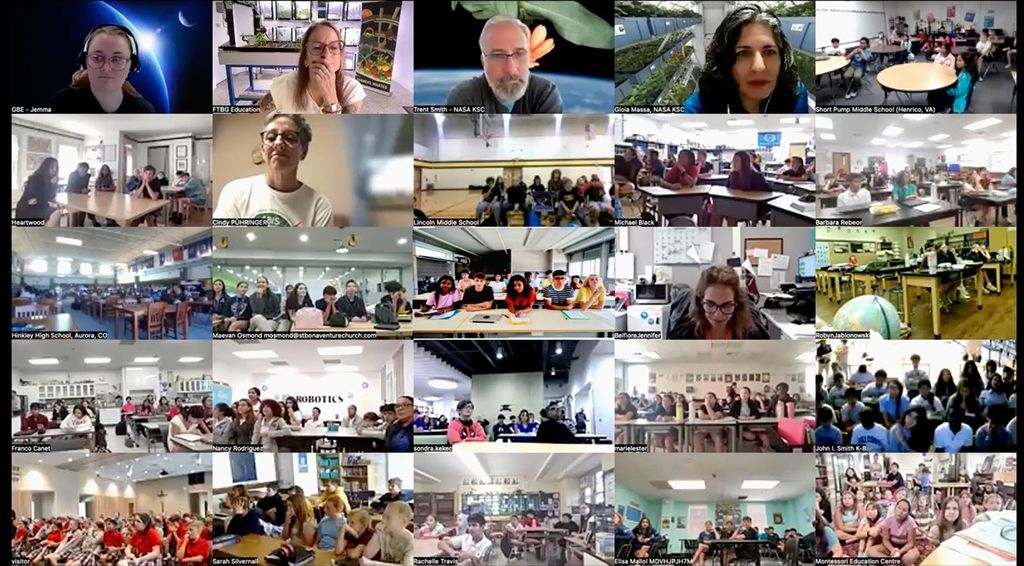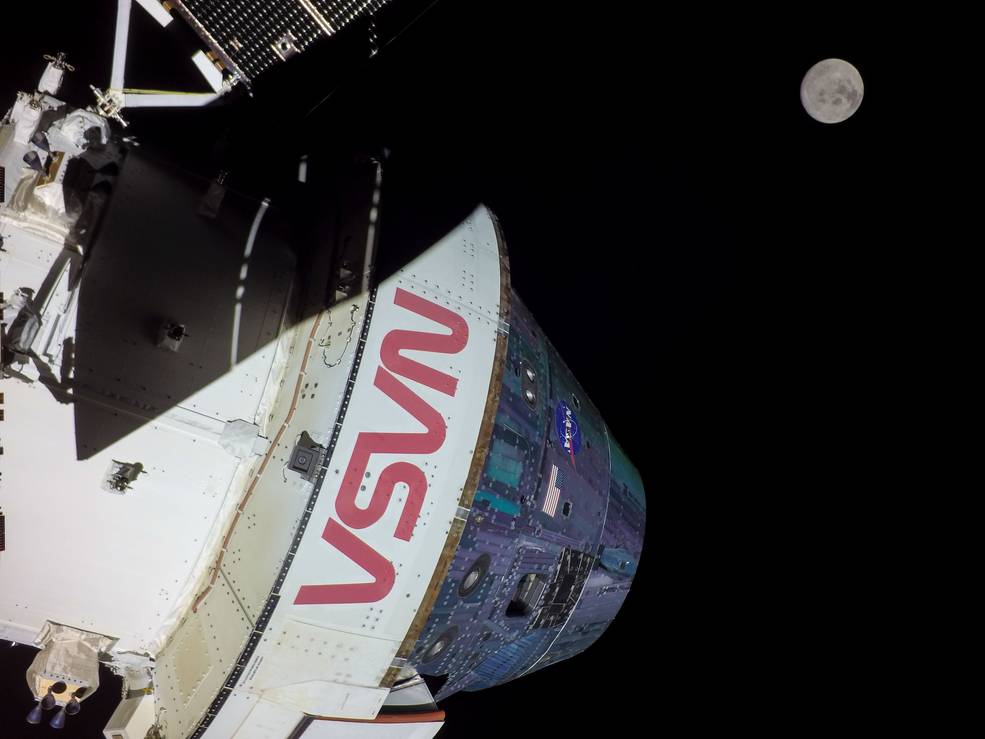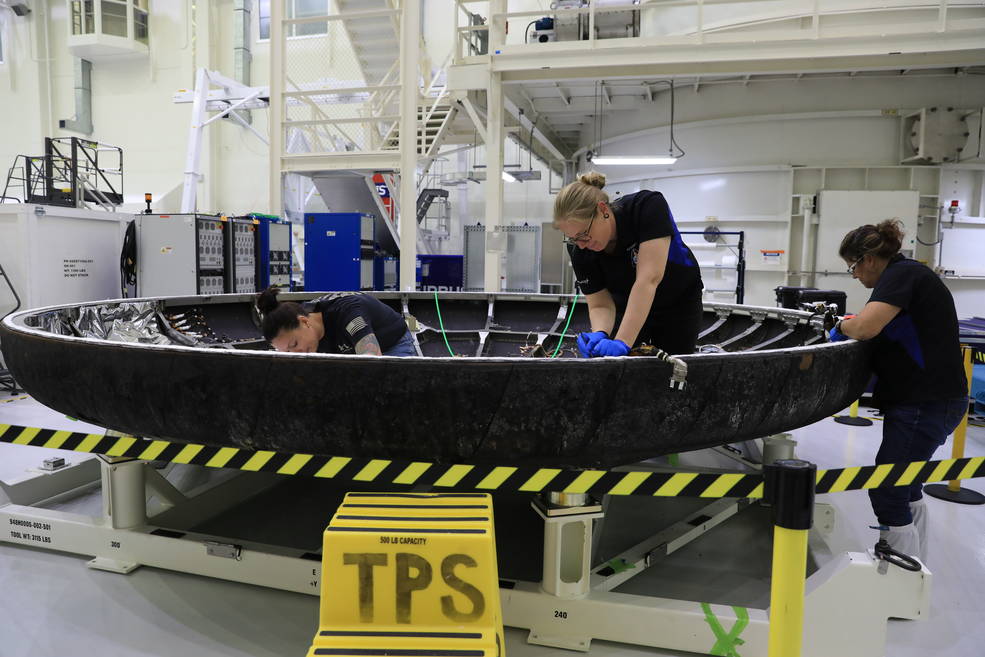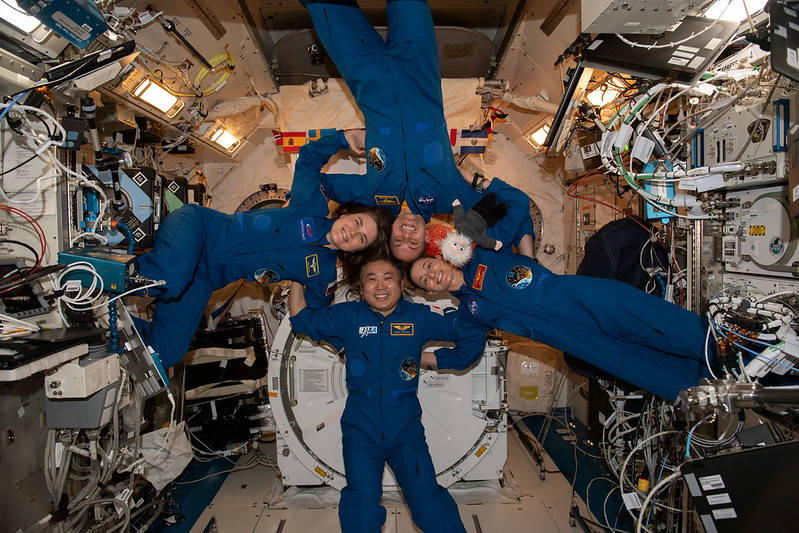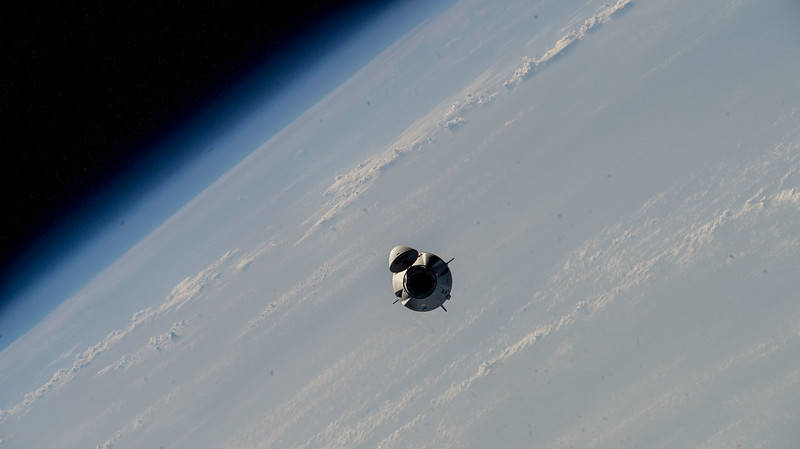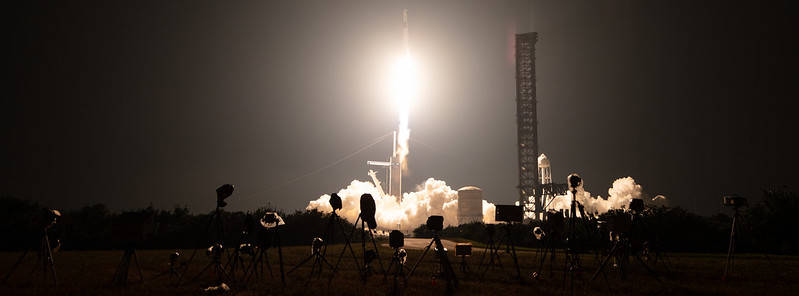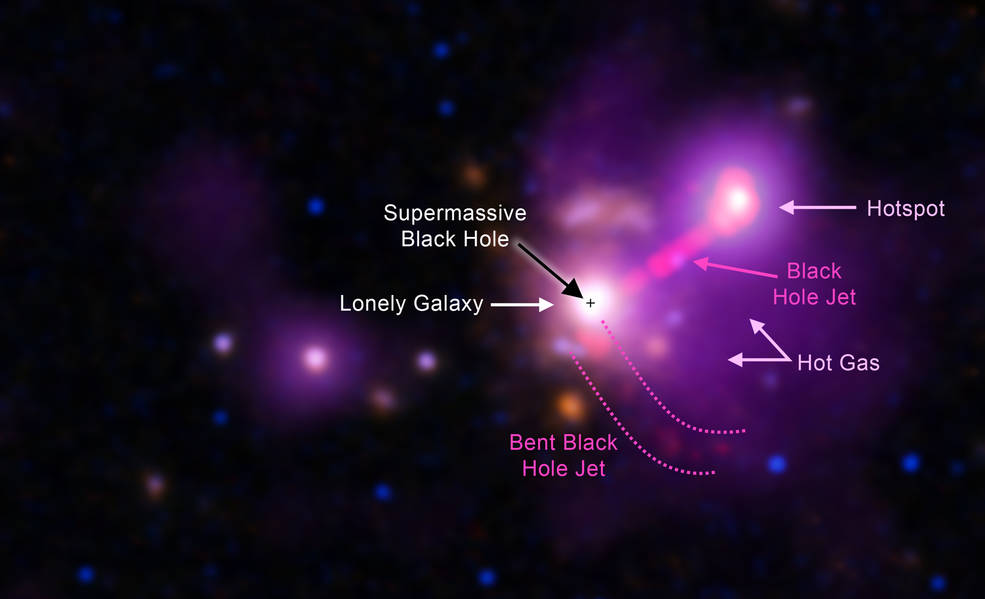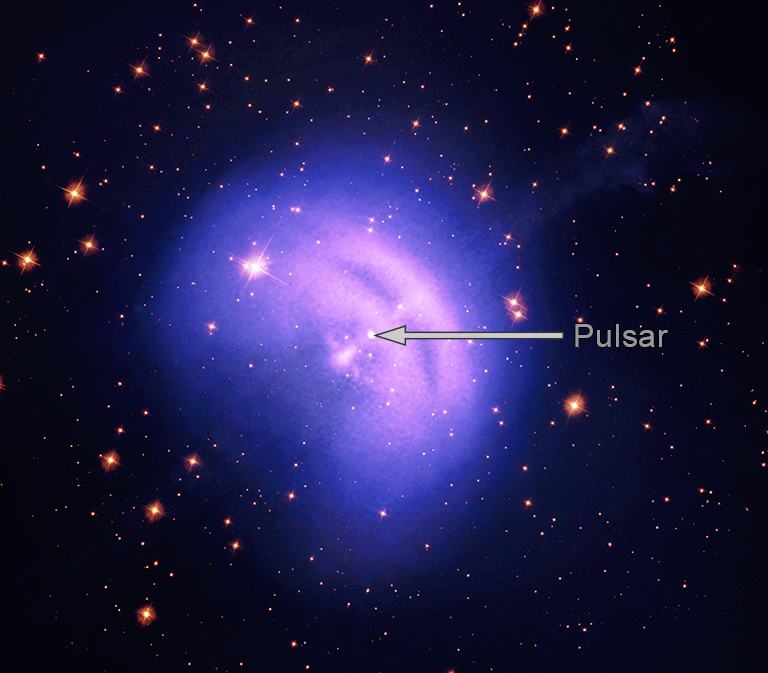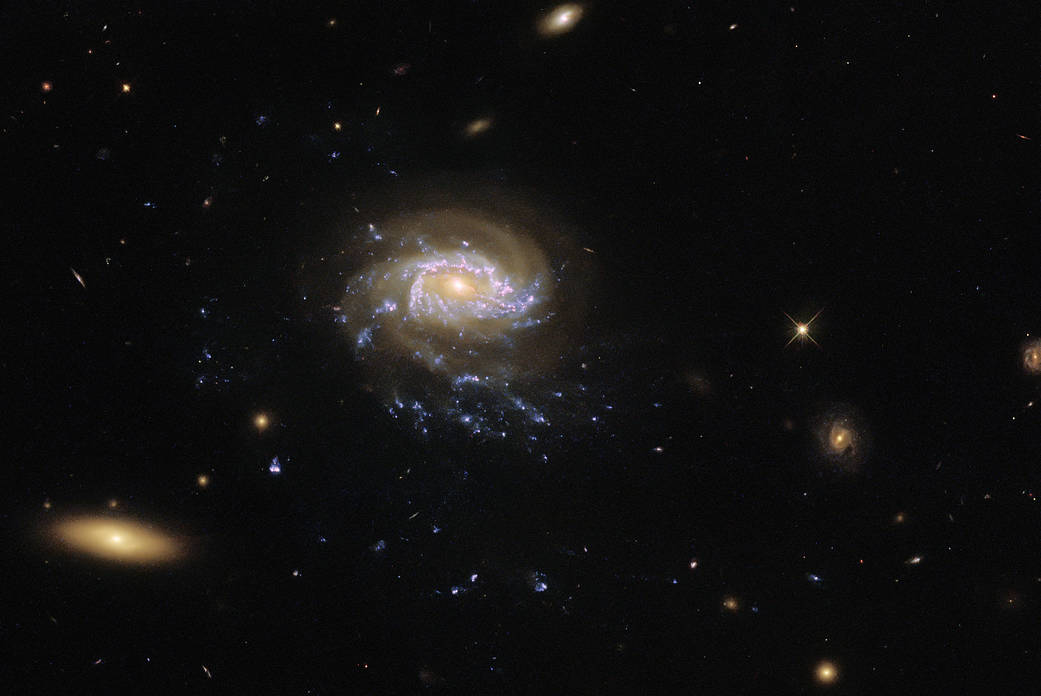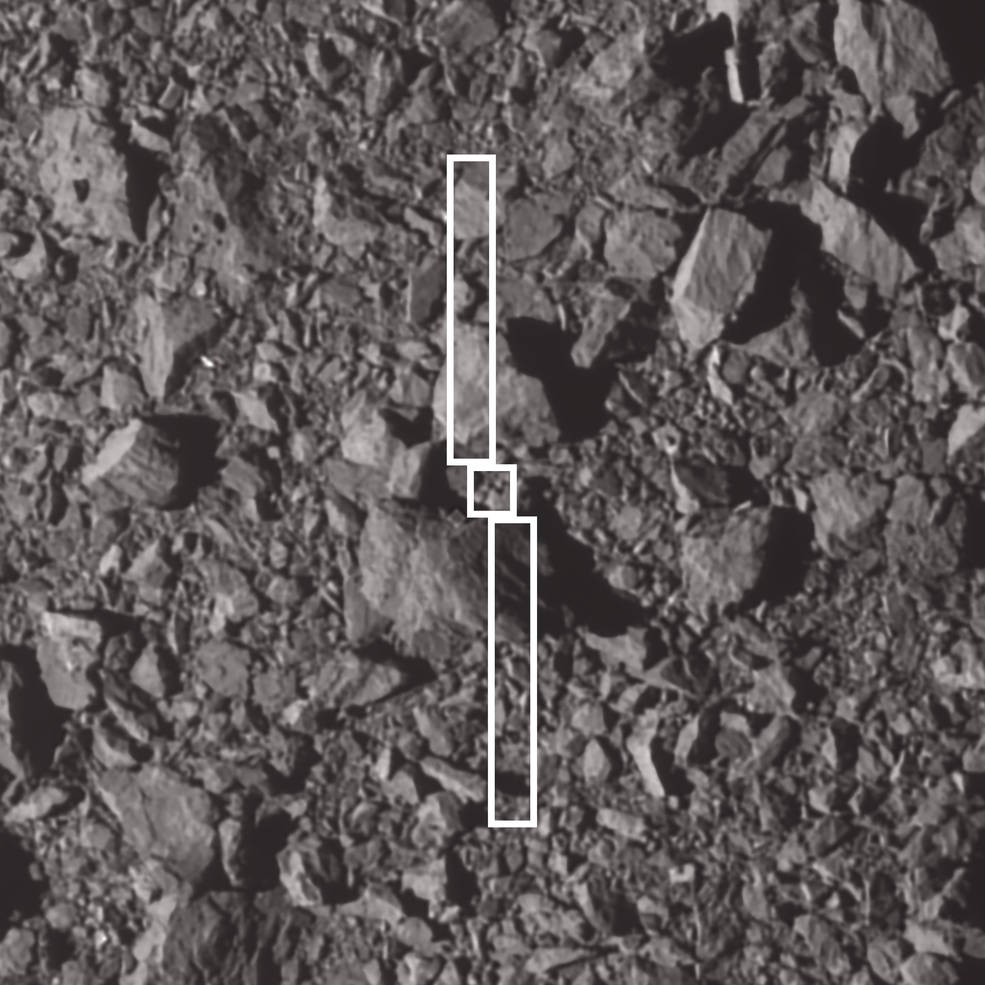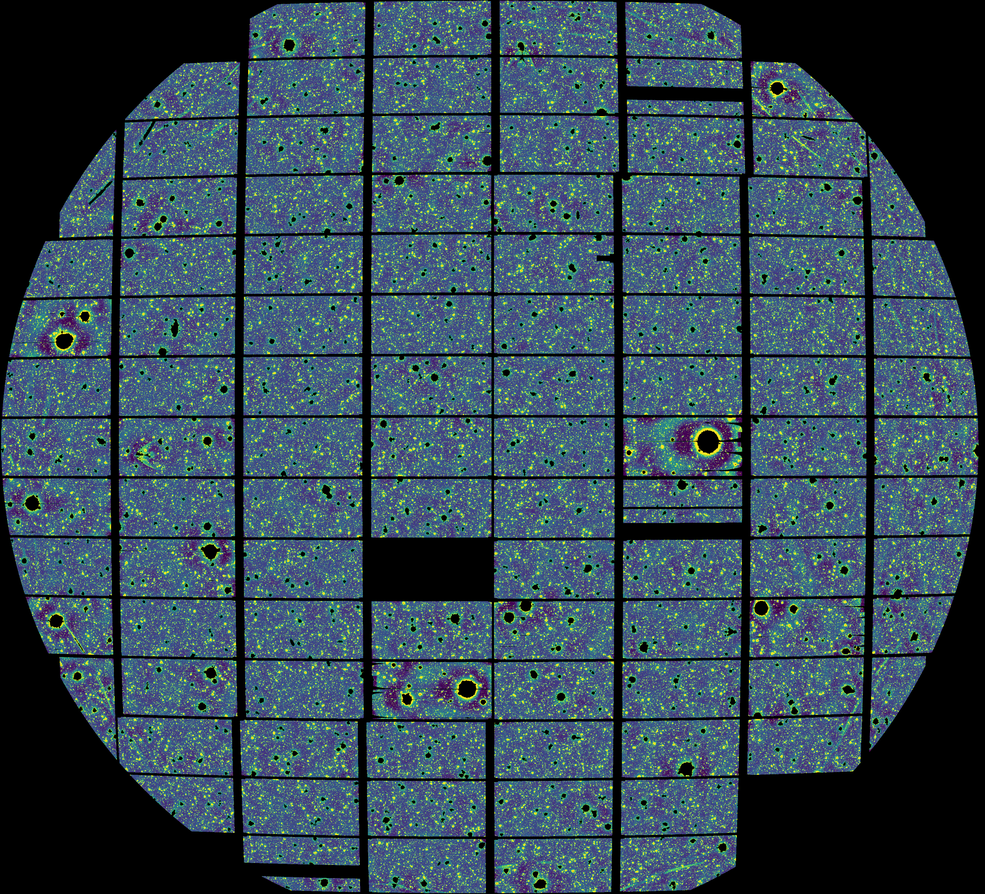In This Week’s Star
- Analysis Confirms Successful Artemis I Moon Mission, Reviews Continue
- NASA Space Launch System Named Business Alabama Project of the Year
- Space Station: Crew of 11 Staying Focused on Advanced Space Research
- Chandra Helps Astronomers Discover a Surprisingly Lonely Galaxy
- Michoud Breaks Ground on Extensive New Commercial Development
- Vela Pulsar Wind Nebula Takes Flight in New Image from NASA’s IXPE
- Hubble Peers at a Galactic Seascape
- NASA Awards Agencywide Contract for Communication Services
- DART Data Validates Kinetic Impact as Planetary Defense Method
- New Horizons Team Adds AI Smarts to Its Kuiper Belt Object Search
Analysis Confirms Successful Artemis I Moon Mission, Reviews Continue
NASA’s uncrewed Artemis I flight test proved the agency’s deep space rocket, spacecraft, and the ground systems needed for launch and recovery are ready to fly astronauts on missions to the Moon. Since the 2022 flight, engineers have extensively reviewed data to confirm initial observations from the successful mission of NASA’s Space Launch System (SLS) rocket and Orion spacecraft on its 1.4 million-mile mission beyond the Moon.
“We’re learning as much as we possibly can from Artemis I to ensure we fully understand every aspect of our systems and feed those lessons learned into how we plan for and fly crewed missions,” said Jim Free, NASA associate administrator for the Exploration Systems Development Mission Directorate. “Safely flying crew is our top priority for Artemis II.”
Space Launch System
Both initial and more comprehensive analysis of the SLS rocket’s debut flight show the rocket flew as designed and with precision, with all of its systems meeting, and in many cases exceeding, performance expectations. Following a near-perfect trans-lunar injection burn, the rocket’s interim cryogenic propulsion stage and Orion successfully separated, delivering Orion to its initial target orbit and then on a trajectory toward the Moon. NASA’s Marshall Space Flight Center manages the SLS Program.
Exploration Ground Systems
Engineers with NASA’s Exploration Ground Systems program completed detailed assessments of the mobile launcher shortly after launch. Although the launcher sustained more damage than initially expected from the 8.8 million pounds of thrust generated at liftoff by the rocket, work already is underway to repair damaged components in tandem, with planned upgrades in preparation for Artemis II, the first flight with crew.
Mobile launcher damage included corrosion to pneumatic – or air-filled – and cryogenic fueling lines, detached welds on tubing, approximately 60 broken panels and cabinets with instrumentation, and destruction to several elevators and blast shields, which are currently being repaired. Modifications to the mobile launcher to support future Artemis missions are underway and on track, including incorporating elements to support an emergency egress systems at the launch pad.
Orion Spacecraft
Teams also are extensively reviewing more than 155 gigabytes of Orion data to confirm the spacecraft’s successful performance during its journey nearly 270,000 miles beyond the Moon and farther than any spacecraft built for humans has flown.
Orion accomplished 161 test objectives to fully demonstrate every aspect of the spacecraft, including 20 objectives added mid-flight. Data shows the European-built service module generated 20% more power than initial expectations and consumed about 25% less power than predicted. All the spacecraft’s dynamic separation events, such as separation of the launch abort system during ascent and parachute deployment during landing – which involved 375 pyrotechnic devices total – were completed without issue. Splashdown, which was moved 300 miles south due to poor weather, occurred 2.4 miles from the target landing spot, well within requirements.
Upon return to Kennedy Space Center, avionics components earmarked for reuse on Artemis II were removed and refurbished for integration, including phased array antennas, a vision processing unit, GPS receivers, and inertial measurement units. All Artemis I avionics components have been integrated into the Artemis II crew module.
NASA also is more closely examining data for two observations from the flight. Engineers noted variations across the appearance of Orion’s heat shield in which the ablative material that helps protect the capsule from the extreme heat of reentry wore away differently than predicted.
Post-flight inspection shows a significant amount of original Avcoat material remained on Orion. Thermal protection system experts have correlated the timing of descent through the atmosphere with data from hundreds of sensors as well as gathered imagery and video. Teams are assessing this set of data to understand the phenomenon.
Experts also continue to assess an issue seen during the flight where latching current limiters switched open without commanding several times throughout the mission. These switches, which are circuit breaker-like devices that are part of a power conditioning and distribution unit responsible for taking power generated by the solar arrays and preparing it for distribution to systems, help control power to components in the service module. Engineers are reviewing flight data to understand the source of the issue and plan to conduct testing in a flight-like configuration.
Progress Toward Artemis II
While work is underway to understand every issue, NASA is making progress assembling, testing, and processing the elements for Artemis II ahead of the late 2024 mission. The heat shield will be attached to the crew module in May, and the crew module and service module will then be connected ahead of integrated testing. The SLS solid rocket booster motor segments and core stage will be shipped to Kennedy later this year, after the engine section and RS-25 engines are connected to the rest of the already-complete stage. Teams expect to transport the mobile launcher to launch pad 39B this summer for testing, including evaluation of the emergency egress capability needed for Artemis II. The recovery team, along with personnel from the Department of Defense, recently completed rigorous testing of a new crew module test article in support of Artemis II efforts and will conduct open water recovery testing in the coming months to ensure the crew on board are quickly and safely removed from the spacecraft.
NASA Space Launch System Named Business Alabama Project of the Year
Sharon Cobb, right, associate program manager of NASA’s Space Launch System (SLS) Program, accepts the Project of the Year award from Business Alabama at a luncheon in Birmingham on March 3. Cobb represented SLS and accepted the award from Miss Alabama 2021 Lauren Bradford, left, and Alec Harvey, editor of Business Alabama, center, during the inaugural awards luncheon and ceremony. The SLS rocket was one of nine finalists for the project of the year following its successful launch in November 2022 during the Artemis I mission. Nominations for the award opened in September 2022 and editorial staff from across the state selected the finalists. NASA’s Marshall Space Flight Center manages the SLS Program. (Business Alabama)
Space Station: Crew of 11 Staying Focused on Advanced Space Research
The International Space Station’s 11 residents are comprised of three individual crews that arrived at the orbital outpost on three different crew ships. The most recent crew to arrive was SpaceX Crew-6 docking on March 3 at 12:40 a.m. CST in the Crew Dragon Endeavour vehicle. The Crew-6 mission launched March 1 at 11:34 p.m. CST from NASA’s Kennedy Space Center.
The four Crew-6 members are now Expedition 68 flight engineers embarking on a six-month space research mission. The new station crewmates are Stephen Bowen and Woody Hoburg of NASA along with Sultan Alneyadi of UAE (United Arab Emirates) and Andrey Fedyaev of Roscosmos. They are familiarizing themselves with station operations, systems, and emergency procedures.
The new quartet is also beginning standard science and maintenance activities. Bowen and Hoburg started a new experiment March 7 conducting ultrasound scans and collecting blood pressure measurements to learn how an astronaut’s eyes, brain, and blood vessels change during a space mission. Alneyadi harvested tomatoes collecting them for both scientific analysis and crew consumption for the Veg-05 space botany study. Fedyaev wore a sensor-packed cap and practiced futuristic piloting techniques on a computer a crew member might use to control spacecraft or robots on planetary missions.
Another four crewmates are due to complete their station mission this month. Astronauts Nicole Mann and Josh Cassada of NASA, and Koichi Wakata of JAXA (Japan Aerospace Exploration Agency), and cosmonaut Anna Kikina of Roscosmos, launched into space on Oct. 5 from the Kennedy Space Center and joined the Expedition 68 crew after docking on Oct. 6.
The homebound foursome is handing over their responsibilities to the station’s newest crew members as well as gathering cargo and personal items to take back to Earth inside Endurance. Mann and Wakata are also finalizing science work as they serviced a variety of research samples and replaced experiment hardware March 7. Mann also joined Cassada and tested and changed out orbital plumbing components. Kikina tested a specialized suit that may help crew members adapt quicker to the return to Earth’s gravity.
Station Commander Sergey Prokopyev has been on the orbiting lab since arriving on Sept. 21 aboard the Soyuz MS-22 crew ship with flight engineers Dmitri Petelin of Roscosmos and Frank Rubio of NASA. Prokopyev and Petelin spent March 7 maintaining various electrical and life support systems. Rubio worked on human research throughout the day swapping samples in science freezers, photographing Bowen and Hoburg during their experiment work, and finally collecting blood specimens for stowage and analysis. The station trio are continuing their stay in space and will return to Earth later this year aboard the Soyuz MS-23 crew ship.
Chandra Helps Astronomers Discover a Surprisingly Lonely Galaxy
A galaxy called 3C 297 is lonelier than expected after it likely pulled in and absorbed its former companion galaxies. The solo galaxy is located about 9.2 billion light-years from Earth and contains a quasar, a supermassive black hole pulling in gas at the center of the galaxy and driving powerful jets of matter seen in radio waves. This result made with NASA’s Chandra X-ray Observatory and the International Gemini Observatory may push the limits for how quickly astronomers expect galaxies to grow in the early universe.
In several regards, 3C 297 has the qualities of a galaxy cluster, a gigantic structure that contains hundreds or even thousands of individual galaxies. X-ray data from Chandra reveal large quantities of gas heated to millions of degrees – a signature feature of a galaxy cluster. Astronomers also found a jet from the quasar – seen by the Karl G. Jansky Very Large Array – that has been bent by interacting with its surroundings. Finally, Chandra data shows evidence that the other quasar jet has smashed into the gas around it, creating a “hotspot” of X-rays. These are typically characteristics of a galaxy cluster. Yet, data from the Gemini Observatory show there is only one galaxy in 3C 297. The 19 galaxies that appear close to 3C 297 in a Gemini image are actually at much different distances.
In this new composite image, Chandra data is colored purple, VLA data is red and Gemini data is green. Visible light and infrared data from the Hubble Space Telescope (blue and orange respectively) have also been included. The lonely galaxy (3C 297) and the position of its supermassive black are identified in a labeled version of the image, along with the black hole’s jets, the X-ray hotspot and the hot gas. The field of view of this image is too small to show any of the 19 galaxies that are not at the same distance as 3C 297.
One proposal for what happened to the missing galaxies is that the gravitational pull of the largest galaxy, combined with the interactions between them, caused the companion galaxies to fall and be assimilated by the alpha. The team considers 3C 297 is most likely a “fossil group” instead of a galaxy cluster, a stage of galactic evolution where one galaxy is pulling in and merging with others. If that is the case, 3C 297 represents the most distant fossil group ever found.
The authors cannot rule out the presence of dwarf galaxies around 3C 297, but their presence would still not explain the lack of larger galaxies like the Milky Way. Nearby examples are M87 in the Virgo Cluster, which has had large galactic companions for billions of years. However, 3C 297 will spend billions of years essentially alone.
The new study was published in the January 2023 issue of The Astrophysical Journal, available here. Earlier Chandra observations lasting only three hours showed hints of the hot gas seen in the new study, as reported by co-author Chiara Stuardi in a paper published in the April 2018 issue of The Astrophysical Journal Supplement Series, available here. Much deeper Chandra observations, however, were required to confirm it. The Chandra observations of 3C 297 were taken over a total time of 2.5 days in April and August of 2021 and 2022.
NASA’s Marshall Space Flight Center manages the Chandra program. The Smithsonian Astrophysical Observatory’s Chandra X-ray Center controls science operations from Cambridge, Massachusetts, and flight operations from Burlington, Massachusetts.
Michoud Breaks Ground on Extensive New Commercial Development
By Matt Higgins
Private industry and state and local public officials joined NASA Michoud Assembly Facility Director Lonnie Dutreix to break ground on a 50-acre development at the campus of the 829-acre facility Feb. 28 that is expected to be a major economic stimulus for the New Orleans region.
“Michoud is a unique NASA facility because we build spaceflight hardware for NASA, but we also host about 20 other government and commercial entities,” Dutreix said. “That model offsets operating costs and it’s a win-win for us and the tenants.”
NASA provides space to commercial and government tenants through its Extended Use Lease (EUL) agreements. EUL’s allow federal agencies to participate in real estate contracts with private and government entities to lease underutilized property and apply the proceeds to reduce overhead. The agency partnered with Industrial Realty Group in 2021 to develop available greenspace on the facility site for commercial use.
“Michoud is not only the nation’s rocket factory but an innovator, which is critical for the future,” said Jeff Schwartz from the City of New Orleans Mayor’s Office.
The area under development will provide warehousing. Once completed, the new warehouse will be the first constructed building on-site in more than a decade. Current Michoud tenant Textron Systems Marine & Land Systems will move into Building A of the new warehouse once construction is completed. Textron designs and manufactures specialty vehicles and equipment for military and commercial use. Textron uses Michoud as a base of operations for its marine and land systems.
IRG President Stu Lichter is confident additional tenants will seek out the available space.
“NASA has been an unbelievable tenant since day one,” Lichter said. “There’s a real demand to be near NASA.”
Michoud has been a site for commercial activity for decades. Prior to its inception as a NASA facility in 1961, Michoud served as an airplane assembly plant during World War II and a tank engine factory during the Korean War. Today, in addition to its primary role as the manufacturer of the Space Launch System and Orion Spacecraft, the facility serves as a major economic engine for the region.
The area under development will be the largest the region has seen in more than two decades. In its unique role as the nation’s space agency, NASA acts as a catalyst for economic activity through its public-private partnerships. NASA’s economic impact on Louisiana includes 2,601 jobs, $150.1 million in labor income, and $493.6 million in economic output. These economic activities generate nearly $16.2 million in tax revenues for the state and local governments in Louisiana, according to a NASA economic impact report.
“The connection to NASA isn’t just about space,” said Oliver Thomas, a City of New Orleans councilmember. “The connection to NASA comes from everyone in this city and to have another investment (in the city of New Orleans) is tremendous. We’re more than just a tourism economy, and with NASA as the anchor, the other partners have seen the value of the infrastructure here. I’m looking forward to the future.”
Higgins, a Manufacturing Technical Solutions Inc. employee, works in communications at Michoud Assembly Facility.
Vela Pulsar Wind Nebula Takes Flight in New Image from NASA’s IXPE
About 10,000 years ago, light from the explosion of a giant star in the constellation Vela arrived at Earth. This supernova left behind a dense object called a pulsar, which appears to brighten regularly as it spins, like a cosmic lighthouse. From the surface of this pulsar, winds of particles emerge that travel near the speed of light, creating a chaotic hodgepodge of charged particles and magnetic fields that crash into surrounding gas. This phenomenon is called a pulsar wind nebula.
In this new image, the hazy light blue halo corresponds to the first-ever X-ray polarization data for Vela, which comes from NASA’s Imaging X-ray Polarimetry Explorer, or IXPE. A faint blue fuzzy line pointing to the upper right-hand corner corresponds to a jet of high-energy particles shooting out from the pulsar at about half the speed of light. The pink X-ray “arcs” are thought to mark the edges of donut-shaped regions where the pulsar wind shocks and accelerates high-energy particles. The pulsar itself is located at the white circle at the center of the image.
Pink and purple colors correspond to data from NASA’s Chandra X-ray Observatory, which has observed Vela several times previously. The golden stars were captured by NASA’s Hubble Space Telescope.
Measuring polarization, which has to do with how electromagnetic waves are organized, gives scientists an unprecedented understanding of how a cosmic object like a pulsar accelerates particles to high speeds.
“With IXPE, we are using extreme objects like Vela as a laboratory to investigate some of the most pressing questions in astrophysics, such as how particles get catapulted to near the speed of light long after a star has exploded,” said Phil Kaaret, senior scientist at NASA’s Marshall Space Flight Center.
In a recent study, scientists were surprised about the high degree of polarization they found in the X-rays at the Vela pulsar wind nebula. IXPE observations of this object were published in the journal Nature in December.
“This is the highest degree of polarization measured in a celestial X-ray source to date,” said Fei Xie, lead author of the Nature study, professor at Guangxi University in Nanning, Guangxi, China, and formerly a postdoctoral researcher at Italy’s National Institute for Astrophysics/Institute for Space Astrophysics and Planetology (INAF/IAPS) in Rome.
High polarization means that the electromagnetic fields are well organized; they are lined up in specific directions, and depend on their position in the nebula. What’s more, the X-rays that IXPE detects come from high-energy electrons spiraling in the magnetic fields of the pulsar wind nebula, called “synchrotron emission.” Highly polarized X-rays means that these magnetic fields, too, must be well organized.
In contrast to supernova remnants that have a shell of material around them, the high polarization of the X-rays “suggests that the electrons were not accelerated by the turbulent shocks that seem important in other X-ray sources,” said Roger W. Romani, a Stanford astrophysicist involved in the IXPE data analysis. Instead, there must be some other process involved, such as magnetic reconnection, which involves the breaking and joining of magnetic field lines. That is a way in which magnetic energy gets converted to particle energy.
IXPE data also suggest that the magnetic field is aligned as a smooth donut-shaped structure around the equator of the pulsar. This shape was in line with scientists’ expectations.
“This IXPE X-ray polarization measurement adds a missing piece of the Vela pulsar wind nebula puzzle,” says Alessandro Di Marco, a researcher at INAF/IAPS in Rome who contributed to the data analysis. “By mapping with unprecedented resolution, IXPE unveils the magnetic field in the central region, showing agreement with results obtained from radio images of the outer nebula.”
The Vela pulsar, located about 1,000 light-years from Earth, is about 15 miles in diameter and rotates 11 times per second, faster than a helicopter rotor.
Part of NASA’s Small Explorer mission series, IXPE launched on a Falcon 9 rocket from NASA’s Kennedy Space Center in December 2021. It now orbits 370 miles above Earth’s equator. The mission is a partnership between NASA and the Italian Space Agency, with partners and science collaborators in 13 countries. Ball Aerospace, headquartered in Broomfield, Colorado, manages spacecraft operations.
Hubble Peers at a Galactic Seascape
A “jellyfish galaxy” with trailing tentacles of stars hangs in inky blackness in this image from the NASA/ESA Hubble Space Telescope. As jellyfish galaxies move through intergalactic space, gas is slowly stripped away forming trails that resemble tendrils illuminated by clumps of star formation. These blue tendrils are visible below the core of this galaxy, giving it a jellyfish-like appearance. This particular jellyfish galaxy – known as JO201 – lies in the constellation Cetus, which is named after a sea monster from ancient Greek mythology. This sea-monster-themed constellation adds to the nautical theme of this image. The tendrils of jellyfish galaxies extend beyond the bright disk of the galaxy’s core. This particular observation comes from an investigation into the sizes, masses, and ages of clumps of star formation in the tendrils of jellyfish galaxies. Astronomers hope this will provide a better understanding of the connection between ram-pressure stripping – the process that creates the tendrils of jellyfish galaxies – and star formation. Hubble’s Wide Field Camera 3 (WFC3) captured this galactic seascape. A versatile instrument that captures images at ultraviolet, infrared, and visible wavelengths, WFC3 is the source of some of Hubble’s most spectacular images. (ESA/Hubble & NASA, M. Gullieuszik)
NASA Awards Agencywide Contract for Communication Services
NASA has selected PCI Productions LLC of Huntsville to manage communication services for all agency centers including headquarters, as well as its mission directorates, to enable the widest practicable and appropriate dissemination of NASA information.
“This is one major step in our overall procurement strategy for communications that will allow us to more efficiently and effectively use the amazing capability of NASA communications organizations to connect the world with the agency’s missions,” said Johnny Stephenson, deputy associate administrator for Communications at NASA Headquarters in Washington.
The NASA Communication Services contract is a firm-fixed-price contract with an indefinite-delivery/indefinite-quantity ordering mechanism for obtaining additional services via task orders. The contract period of performance consists of a 16-month base period that begins on June 1, 2023, followed by one 20-month option period, and two one-year option periods. The potential value of the contract is approximately $217.6 million, which includes the base plus option periods and the maximum IDIQ ordering value of $183 million.
Work to be performed under the contract consists of communication services, including, but not limited to, strategic communications, planning, and integration services; stakeholder relations and public engagement support; media relations services; history and archives services; library services; and services in support of Freedom of Information Act requests.
DART Data Validates Kinetic Impact as Planetary Defense Method
Since NASA’s Double Asteroid Redirection Test (DART) successfully impacted its target nearly five months ago, on Sept. 26 – altering the orbit of the asteroid moonlet Dimorphos by 33 minutes – the DART team has been hard at work analyzing the data collected from the world’s first planetary defense test mission.
The DART mission employed an asteroid-deflection technique known as a “kinetic impactor,” which in simplest terms means smashing a thing into another thing – in this case, a spacecraft into an asteroid. From the data, the DART investigation team, led by the Johns Hopkins Applied Physics Laboratory (APL) in Laurel, Maryland, found that a kinetic impactor mission like DART can be effective in altering the trajectory of an asteroid, a big step toward the goal of preventing future asteroid strikes on Earth. These findings were published in four papers in the journal Nature.
“I cheered when DART slammed head on into the asteroid for the world’s first planetary defense technology demonstration, and that was just the start,” said Nicola Fox, associate administrator for the Science Mission Directorate at NASA Headquarters in Washington. “These findings add to our fundamental understanding of asteroids and build a foundation for how humanity can defend Earth from a potentially hazardous asteroid by altering its course.”
The first paper reports DART’s successful demonstration of kinetic impactor technology in detail: reconstructing the impact itself, reporting the timeline leading up to impact, specifying in detail the location and nature of the impact site, and recording the size and shape of Dimorphos.
The authors, led by Terik Daly, Carolyn Ernst, and Olivier Barnouin of APL, note DART’s successful autonomous targeting of a small asteroid, with limited prior observations, is a critical first step on the path to developing kinetic impactor technology as a viable operational capability for planetary defense.
Their findings show intercepting an asteroid with a diameter of around half a mile, such as Dimorphos, can be achieved without an advance reconnaissance mission, though advance reconnaissance would give valuable information for planning and predicting the outcome. What is necessary is sufficient warning time – several years at a minimum, but preferably decades. “Nevertheless,” the authors state in the paper, DART’s success “builds optimism about humanity’s capacity to protect the Earth from an asteroid threat.”
The second paper uses two independent approaches based on Earth-based lightcurve and radar observations. The investigation team, led by Cristina Thomas of Northern Arizona University, arrived at two consistent measurements of the period change from the kinetic impact: 33 minutes, plus or minus one minute. This large change indicates the recoil from material excavated from the asteroid and ejected into space by the impact (known as ejecta) contributed significant momentum change to the asteroid, beyond that of the DART spacecraft itself.
The key to kinetic impact is that the push to the asteroid comes not only from colliding spacecraft, but also from this ejecta recoil. The authors conclude: “To serve as a proof-of-concept for the kinetic impactor technique of planetary defense, DART needed to demonstrate that an asteroid could be targeted during a high-speed encounter and that the target’s orbit could be changed. DART has successfully done both.”
In the third paper, the investigation team, led by Andrew Cheng of APL, calculated the momentum change transferred to the asteroid as a result of DART’s kinetic impact by studying the change in the orbital period of Dimorphos. They found the impact caused an instantaneous slowing in Dimorphos’ speed along its orbit of about 2.7 millimeters per second – again indicating the recoil from ejecta played a major role in amplifying the momentum change directly imparted to the asteroid by the spacecraft. That momentum change was amplified by a factor of 2.2 to 4.9 (depending on the mass of Dimorphos), indicating the momentum change transferred because of ejecta production significantly exceeded the momentum change from the DART spacecraft alone.
This finding “[validates] the effectiveness of kinetic impact for preventing future asteroid strikes on the Earth,” the authors conclude.
DART’s scientific value goes beyond validating kinetic impactor as a means of planetary defense. By smashing into Dimorphos, the mission has broken new ground in the study of asteroids. DART’s impact made Dimorphos an “active asteroid” – a space rock that orbits like an asteroid but has a tail of material like a comet – which is detailed in the fourth paper led by Jian-Yang Li of the Planetary Science Institute.
Although scientists had proposed that some active asteroids are the result of impact events, until now no one had ever observed the activation of an asteroid. The DART mission activated Dimorphos under precisely known and carefully observed impact conditions, enabling the detailed study of the formation of an active asteroid for the first time.
“DART, as a controlled, planetary-scale impact experiment, provides a detailed characterization of the target, the ejecta morphology, and the entire ejecta evolution process,” the authors write. “DART will continue to be the model for studies of newly discovered asteroids that show activity caused by natural impacts.”
DART’s Legacy Begins
“We are so proud of the DART team and the investigation’s latest results,” said Jason Kalirai, Civil Space Mission Area Executive at APL. “With the core analysis activities starting after the impact of Dimorphos, the results demonstrate how successful the kinetic impactor technique can be – paving the way for a bright future for planetary defense.”
Johns Hopkins APL manages the DART mission for NASA’s Planetary Defense Coordination Office as a project of the agency’s Planetary Missions Program Office, which is at NASA’s Marshall Space Flight Center. The LICIACube project is managed by ASI Robotic Exploration Mission Office, with industrial contractor Argotec S.r.I. and a scientific team from the National Institute of Astrophysics, Polytechnic University of Milan, the University of Bologna, the University of Naples Parthenope, and CNR-IFAC.
For more information about DART, visit https://www.nasa.gov/dartmission.
New Horizons Team Adds AI Smarts to Its Kuiper Belt Object Search
By early 1930, Lowell Observatory junior astronomer Clyde Tombaugh had spent months poring over hundreds of telescopic photo plates in the search for a single moving object – which would turn out to be Pluto, the ninth planet.
Nearly a century later, the team that famously explored the planet Tombaugh discovered is expanding its own search for additional targets of discovery – and doing it with technology that would have astounded Tombaugh.
NASA’s New Horizons spacecraft followed up its historic flyby of Pluto in 2015 with the first-ever close encounter with a Kuiper Belt object (KBO), called Arrokoth, in 2019 – a billion miles beyond distant Pluto. Four years later the spacecraft is yet another billion miles farther out and continues to speed through the outer reaches of the solar system, now more than 5 billion miles from Earth. As New Horizons has crossed the Kuiper Belt, it has been taking advantage of its unique location and capabilities to study dozens of other KBOs in multiple ways that can’t be done from Earth.
Key to this is discovering KBOs to study near the path of New Horizons. Those searches use two of the world’s largest telescopes – the Japanese Subaru Telescope in Hawaii and the Cerro Tololo Inter-American Observatory’s Victor M. Blanco telescope in Chile. The New Horizons team has enhanced these searches using artificial intelligence – machine learning data-analysis tools, developed in 2021 and refined last year, that dramatically increase the team’s KBO detection rates over what human scouring of the data yielded in the past.
Using machine-learning AI software, mission co-investigators JJ Kavelaars of the University of British Columbia and Wes Fraser of the Canadian National Research Council have sped up and made those searches far more productive. This software employs a convolutional neural network, a deep-learning algorithm that can take an input image, assign importance to various objects in the image, and be able to differentiate one object from another.
The team has applied its tool to data acquired with the giant Hyper Suprime-Cam camera on the Subaru Telescope, as part of a search for targets for the New Horizons spacecraft. “The software network’s classification performance is extremely good, significantly cutting back on ‘false’ candidate sources,” said Fraser. “An entire night’s worth of search data requires only a few hours of human vetting. Compare that to the weeks it used to take to do this!”
Given its size and wide field-of-view – the largest of any operating giant telescope – the Subaru Telescope is the best tool on Earth for finding new KBOs for New Horizons to study or even fly by. The first search, in May-August 2020 (along with some follow-up time in October), produced about 87 new KBOs found in the direction New Horizons is traveling.
When the team reran 2020 search data through the AI software, it not only worked 100 times faster, but it turned up 67 more KBOs that human searchers had not found in the images. Some of those more than 100 newly detected, ancient KBOs are scheduled to be observed by the instrumentation aboard New Horizons through 2024.
Even further boosting the Subaru effort is a more efficient sky filter the mission provided for the telescope that began operations on Subaru in 2022.
“This is a new, game-changing tool we’ll be taking advantage of for years to come,” said Alan Stern, New Horizons principal investigator from the Southwest Research Institute in Boulder, Colorado.
None of the KBOs found is close enough for New Horizons to fly closely past, but nearly 20 passed close enough (millions of miles) for the spacecraft to observe from a distance – revealing information on their surface properties, shapes, rotational periods, and close-in orbiting moons that could not be achieved by any other method except New Horizons.
On the prospect of a new flyby target KBO for New Horizons, team members point out that the search for such an object is a longshot – a cosmic needle-in-a-haystack challenge – but they also recall that the search for Arrokoth took four years, before they discovered Arrokoth.
“The potential for groundbreaking discoveries in another KBO flyby is too great, so we continue searching,” said Stern. “We are in this for the long game, and AI is here to help!”
The Johns Hopkins Applied Physics Laboratory in Laurel, Maryland, designed, built, and operates the New Horizons spacecraft, and manages the mission for NASA’s Science Mission Directorate. Southwest Research Institute, in San Antonio and Boulder, Colorado, directs the mission via Principal Investigator Alan Stern, and leads the science team, payload operations and encounter science planning. New Horizons is part of the New Frontiers Program managed by NASA’s Marshall Space Flight Center.


















